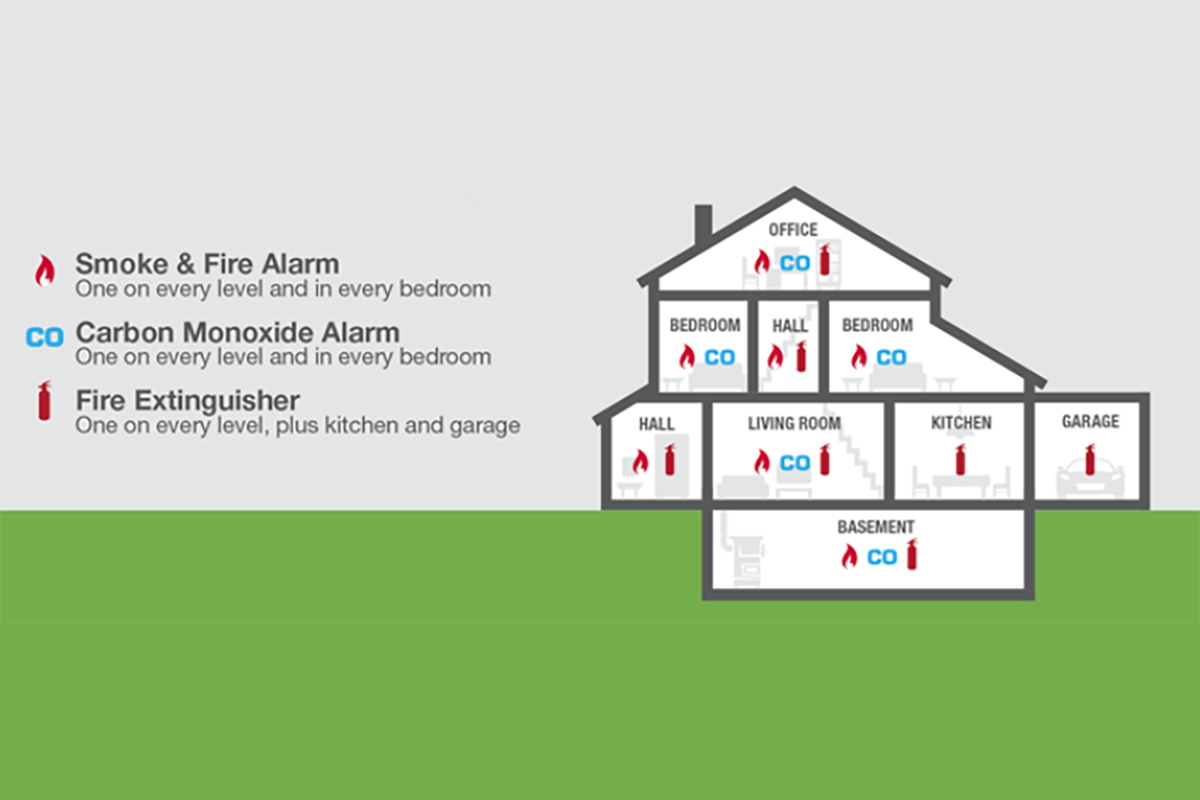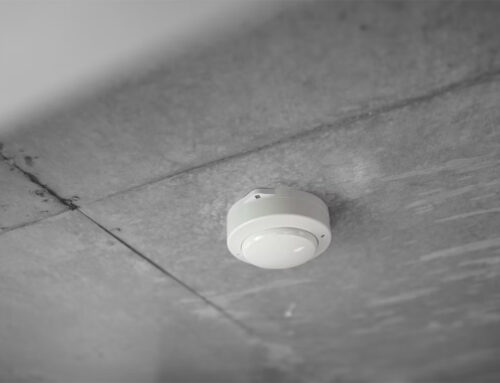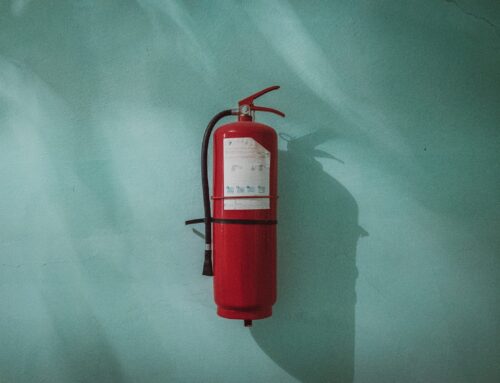Minimum coverage for Smoke alarms, CO alarms, and fire extinguishers:
- Smoke Alarms: One on every level and in every bedroom. Use Heat Alarms where smoke alarms can’t be used.
- Carbon Monoxide (CO) Alarms: One on every level and in every bedroom as well as any room containing a fuel-burning appliance.
- Fire Extinguishers: One on every level, one in the kitchen, and one in the garage.
Specific legal requirements for smoke and CO alarm installation vary from state to state and from region to region. Check with your local Fire Department for current requirements in your area or visit the First Alert state legislation page.
NOTE:
Contrary to a popular myth about CO, carbon monoxide alarms do not need to be installed near the floor to be effective.
Alarm Placement Guidelines
The following locations should be avoided in Smoke, CO and Explosive Gas Alarm installations. These locations may cause nuisance alarms or reduce the performance of your alarm.
- Avoid dusty, dirty, or greasy areas:
-
- garages
- furnace rooms
- crawl spaces
- unfinished attics
- Avoid combustion particles. Combustion particles form when fuel burns. Avoid kitchens, garages, and furnace rooms. Keep units at least 20 feet (6 meters) away from common sources of combustion particles. In small homes, where 20-foot distance is not possible, place the alarm as far away from fuel-burning sources as possible. Keep the area ventilated to prevent unwanted alarms. Here are common sources of combustion particles in the home:
- stoves
- heaters
- furnaces
- water heaters
- space heaters
- Install at least 5 feet (1.5 meters) away from any cooking appliance. Air currents can draw cooking smoke into the smoke sensor and cause unwanted alarms.
- Avoid humid areas. Install your alarm at least 10 feet (3 meters) from common sources of humidity:
- shower
- bath
- sauna
- humidifier
- vaporizer or diffuser
- dishwasher
- laundry room
- utility room
- Keep alarms out of direct sunlight.
- Avoid turbulent air near ceiling fans or open windows. Blowing air may prevent Smoke, CO or Gas from reaching the sensors.
- Avoid placing near HVAC vents which can blow air and dust on the unit.
- If there is a ceiling fan in the same room where we want to install our detector, make sure the distance starting at the tip of the Ceiling fan Blade is at least 36 Inches (3 feet) to the detector.
- Avoid areas where the temperature is colder than 40˚ F (4.4˚ C) or hotter than 100˚ F (37.8˚C) such as:
- crawl spaces
- unfinished attics
- uninsulated ceilings
- porches
- garages
- basements
For these locations we recommend using a Heat Detector in place of a smoke detector.
- Avoid insect-infested areas. Insects can clog the openings to the sensing chamber or cause false alarms.
- Install at least 12 inches (300 mm) away from fluorescent lights. Electrical noise can interfere with the sensor.
- For any location, make sure no door or other obstruction could keep carbon monoxide, smoke or gas from reaching the alarm.
- Avoid dead air spaces with no air circulation. Dead air spaces may prevent Smoke, CO or Gas from reaching your alarm. To avoid dead air spaces, follow the installation recommendations below.
When installing an alarm on the wall, the top edge of alarms should be placed between 4 inches (100 mm) and 12 inches (300 mm) from the wall/ceiling line.
When installing an alarm on the ceiling, place the alarm as close to the center as possible.
In either case, install the alarm at least 4 inches (100 mm) from where the wall and ceiling meet.
If you have a sloping, pitched, or cathedral ceiling, the device should be 35 inches (90cm) from the highest peak.
Heat Alarm Placement Guidelines
- Areas with extreme temperatures not caused by fire – locations where daily temperatures exceed the 135º F (57º C) alarm level
- Areas where temperatures are regularly below –20º F (–29º C) or above 115º F (46º C), including unheated buildings, outdoor rooms, or porches.
- Do not install a Heat Alarm directly over the stove or range.
- Near fresh air vents, ceiling fans, or in very drafty areas. Drafts can blow heat away from the unit, preventing it from reaching the sensing chamber.
- Less than 12 inches (305 mm) away from fluorescent lights. Electrical “noise” can interfere with the sensor.
- In “dead air” spaces. For wall mounting (if allowed by building codes), the top edge of Heat Alarms should be placed between 4 inches (102 mm) and 12 inches (305 mm) from the wall/ceiling line, below typical “dead air” spaces. To avoid dead air spaces, follow the installation recommendations below.
Explosive Gas Alarm Placement Guidelines
For Explosive Gas Alarms, in addition to the locations to avoid listed above, mounting depends on the type of explosive gas you intend to detect (If you are not sure what type of gas your home uses, contact your utility company) :
Natural Gas (Methane):
Typically supplied through a main utility line connected to your home. If you do not live in a rural area you are likely to be a user of natural gas. Natural gas is a fossil fuel consisting mainly of Methane. Methane is much lighter than air and will rise rapidly in air. If you are a user of natural gas, the Alarm should be mounted between 6 and 12 inches (152mm and 305 mm) away from the ceiling (using cord feature) to ensure the earliest opportunity to detect a leak.
Propane:
Typically supplied to homes by delivery truck in liquid form and stored near the home in propane tanks. Propane is used by homes in rural areas that do not have natural gas service. Since propane is the most commonly used Liquefied Petroleum Gas (LPG), propane and LP-Gas are often used synonymously. Unlike natural gas, propane is heavier than air and will collect at lower levels. If you are a user of propane, the Alarm should be mounted near the floor (using the direct plug-in feature) to ensure the earliest opportunity to detect a leak.
In general, install combination Explosive Gas and Carbon Monoxide Alarms:
- WHERE YOU CAN HEAR THE ALARM FROM ALL SLEEPING AREAS
- In or near bedrooms and living areas or wherever you suspect a gas or CO exposure is likely.
- On each level of a multi-level home
Read the full article here: support.firstalert.com






Leave A Comment